Text
Unveiling the Power of Excavator Bucket: From Production to Superior Performance
Excavators, the mighty machines capable of moving tons of earth with ease, owe much of their incredible efficiency to one crucial component: the excavator bucket. These robust workhorses have revolutionized the construction and mining industries, enabling efficient digging, loading, and material handling tasks. In this popular science copy, we will delve into the fascinating world of excavator bucket, exploring their production process, design features, and various applications, all contributing to their unrivaled performance.

The Birth of an Excavator Bucket:
The production of an excavator bucket is a meticulous process that involves skilled craftsmanship and advanced manufacturing techniques. High-quality steel plates are meticulously cut and shaped, then welded together to form the sturdy structure of the bucket. Reinforcements and wear-resistant materials are strategically added to ensure durability and extended lifespan.
Design for Performance:
Excavator bucket come in a diverse range of shapes and sizes, each tailored to specific tasks and ground conditions. The two primary designs are the backhoe and face shovel buckets. Backhoe buckets, with their curved bottoms and narrow tips, are ideal for trenching and digging in tight spaces. Face shovel buckets, on the other hand, have flatter bottoms and larger capacities, making them perfect for bulk material handling and excavation.
Reinforced for Toughness:
To withstand the relentless wear and tear in demanding environments, excavator bucket is reinforced with hardened steel components. These wear-resistant plates and cutting edges minimize abrasion and ensure optimal digging efficiency. Innovative designs also incorporate replaceable teeth and adapters, allowing quick and cost-effective maintenance.
Beyond the Basics: Specialized Attachments:
Excavator buckets are highly versatile and can be equipped with various specialized attachments to enhance their functionality. Some popular attachments include grapples for handling loose materials, rippers for breaking up hard surfaces, and thumbs for gripping irregularly shaped objects. This flexibility makes excavator buckets invaluable in a wide range of construction, mining, and demolition applications.

Enhancing Efficiency with Technology:
Advancements in technology have transformed excavator bucket, maximizing their productivity and efficiency. Hydraulic systems now allow operators to control the bucket’s movements with precision, optimizing digging depth and speed. Additionally, sensors and cameras provide real-time data, enabling operators to monitor the bucket’s position, load, and ground conditions, ensuring safer and more efficient operations.
Adaptability for Different Environments:
Excavator buckets are designed to conquer diverse terrains and ground conditions. Specialized buckets are available for specific environments, such as rock buckets for rocky landscapes or ditching buckets for shaping ditches and trenches. Some buckets even feature advanced tilting mechanisms, allowing operators to work on uneven surfaces without compromising efficiency.
Sustainable Solutions:
In recent years, environmental considerations have driven the development of sustainable excavator bucket solutions. Lighter yet durable materials are being used to reduce fuel consumption and carbon emissions. Additionally, advanced hydraulic systems minimize energy consumption, and the adoption of renewable power sources, such as electric excavators, further contributes to a greener future.
The Future of Excavator Buckets:
The evolution of excavator bucket continues as technology advances. Automation and autonomous systems are gradually being integrated, enhancing safety and efficiency on job sites. Furthermore, materials science and engineering breakthroughs may lead to the development of even stronger and lighter bucket materials, improving performance while reducing environmental impact.
Conclusion:
Excavator buckets stand as testament to human ingenuity and innovation, revolutionizing the way we shape the world around us. From their meticulous production process to their versatile design features and innovative technologies, these workhorses enable us to accomplish feats that were once unimaginable. As we continue to push the boundaries
of construction and excavation, the future of excavator buckets holds exciting possibilities. With ongoing advancements in materials, technology, and sustainability, we can anticipate even more efficient, durable, and environmentally friendly solutions.
As we look ahead, automation and autonomous systems are expected to play a significant role in the evolution of excavator bucket. These intelligent machines will be capable of executing repetitive tasks with high precision, minimizing human error and improving overall productivity. With the integration of advanced sensors, machine learning algorithms, and real-time data analysis, excavator buckets will become even more efficient, adaptive, and safer to operate.
Moreover, materials science and engineering research may lead to the development of new materials with superior strength-to-weight ratios. Lightweight yet robust materials will contribute to reducing fuel consumption and carbon emissions, while also allowing excavator buckets to handle heavier loads and operate with increased agility. Additionally, the utilization of advanced composites and coatings may enhance wear resistance, further extending the lifespan of excavator buckets and reducing maintenance requirements.
The quest for sustainability in the construction industry has given rise to eco-friendly initiatives, and excavator buckets are no exception. Manufacturers are actively exploring ways to reduce the environmental impact of these machines. This includes incorporating more recycled materials into the production process, optimizing energy efficiency through hydraulic system improvements, and embracing alternative power sources such as electric excavators. By prioritizing sustainability, excavator buckets can contribute to a greener future by minimizing resource consumption and carbon emissions.
In conclusion, excavator buckets are indispensable tools that have revolutionized the construction and mining industries. From their meticulous production process to their diverse design features and the integration of advanced technologies, they continue to push the boundaries of what is possible. With ongoing advancements in automation, materials science, and sustainability, the future of excavator buckets holds immense potential for increased efficiency, durability, and environmental consciousness. As these machines evolve, they will undoubtedly play a vital role in shaping a sustainable and technologically advanced future.
0 notes
Text
The Excavator Telescopic Arm: Extending Reach and Revolutionizing Construction
In the realm of construction, innovation knows no bounds. One of the most remarkable advancements in heavy machinery is the excavator telescopic arm, a versatile and powerful tool that has transformed the way we approach excavation and construction projects. With its ability to extend and retract, this ingenious piece of engineering has revolutionized the industry, enhancing efficiency, safety, and precision. In this article, we delve into the inner workings of the excavator telescopic arm, exploring its mechanics, applications, and the significant impact it has made on the field.

Unleashing the Power of Extension
The telescopic arm, also known as a boom or stick, is a vital component of an excavator—an essential workhorse of modern construction sites. Traditionally, excavators relied on fixed-length booms, limiting their reach and maneuverability. However, with the advent of the excavator telescopic arm, operators gained unparalleled flexibility and expanded reach.
At the core of this engineering marvel lies a series of nested sections that can extend and retract hydraulically. The arm comprises two or more cylindrical sections nested within one another, with hydraulic cylinders allowing controlled extension and retraction. This mechanism grants the operator the ability to adjust the arm’s length to suit various project requirements, making it possible to work efficiently in confined spaces or reach great distances effortlessly.
Enhancing Versatility and Precision
The telescopic arm’s extendable nature provides an array of benefits that have transformed construction practices. Its versatility enables operators to adapt to a wide range of tasks, from digging trenches and foundations to loading and lifting heavy materials. By adjusting the arm’s length, an excavator can work with precision, ensuring optimal depth, reach, and accuracy, reducing the need for additional equipment or manual labor.
Moreover, the telescopic arm is often equipped with interchangeable attachments, such as buckets, grabs, or hydraulic breakers. These attachments expand the excavator’s capabilities, allowing it to perform specialized tasks without the need for a different machine. With a quick change of attachments, the excavator can seamlessly transition from digging to grading, demolition, or material handling, maximizing efficiency on the construction site.
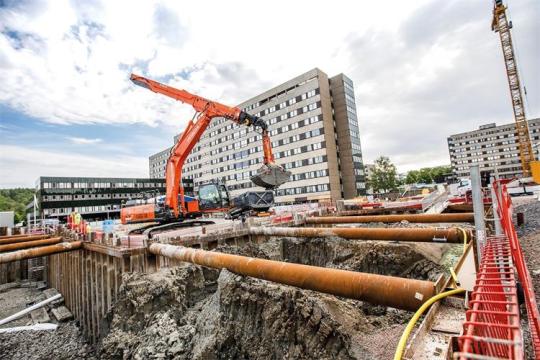
Safety and Efficiency Advancements
The introduction of the telescopic arm has significantly improved safety standards in construction. The arm’s extendable feature reduces the need for excessive machine repositioning, minimizing potential hazards associated with unstable ground conditions or nearby obstacles. This enhanced stability also prevents damage to surrounding structures or utilities, saving time and costly repairs.
Furthermore, the telescopic arm’s extended reach reduces the need for manual labor in hazardous environments. Operators can control the excavator from a safer distance, away from potentially dangerous areas. This technology empowers operators to undertake tasks that would have otherwise been inaccessible or required more time and resources, enhancing overall project efficiency.
Future Possibilities and Innovations
As construction technology continues to evolve, we can anticipate further innovations in the telescopic arm domain. Researchers are exploring advanced materials and design modifications to enhance the arm’s strength, durability, and efficiency. Additionally, developments in automation and robotics may lead to excavators equipped with intelligent telescopic arms capable of performing complex tasks autonomously, further reducing risks and increasing productivity.
Conclusion
The excavator telescopic arm has undoubtedly revolutionized the construction industry. By providing operators with extended reach, adaptability, and precision, this engineering marvel enhances both safety and efficiency on construction sites. With ongoing advancements and future possibilities, we eagerly await further innovations in the field, as telescopic arms continue to shape the future of construction, transforming how we build our cities and infrastructure.
Further Advancements in Telescopic Arm Technology
Continued research and development in telescopic arm technology have paved the way for even more advanced features and capabilities. Engineers are exploring ways to improve the telescopic arm’s performance by integrating advanced sensors and monitoring systems. These innovations enable real-time feedback on load capacities, stability, and operating conditions, ensuring optimal safety and productivity.
Another area of focus is energy efficiency. Efforts are being made to develop telescopic arms that consume less fuel and reduce emissions without compromising power or performance. By utilizing lightweight materials and optimizing hydraulic systems, excavators equipped with telescopic arms can operate more efficiently, reducing both environmental impact and operational costs.
Furthermore, the integration of telematics and connectivity features allows for remote monitoring and diagnostics of telescopic arms. This technology enables fleet managers and operators to track machine performance, schedule maintenance, and identify potential issues proactively, minimizing downtime and improving overall operational efficiency.

Expanding Applications
The versatility and reach of the excavator telescopic arm have opened up new possibilities across various industries. Beyond traditional construction applications, telescopic arms are finding utility in sectors such as mining, forestry, and utility maintenance.
In the mining industry, telescopic arms are used for excavation in challenging terrains, allowing operators to access otherwise inaccessible areas safely. They can also be equipped with specialized attachments for tasks like rock breaking, ore loading, and reclamation work.
Forestry operations benefit from telescopic arms for selective tree harvesting and land clearing. The arm’s reach enables operators to navigate through dense vegetation and handle large logs with ease.
In utility maintenance, telescopic arms assist in tasks such as pole installation and repair, overhead line maintenance, and infrastructure inspection. The extended reach and maneuverability of the arm enable workers to perform these tasks efficiently and safely, minimizing disruptions to services.
Conclusion
The excavator telescopic arm has transformed the construction industry, revolutionizing excavation processes, and increasing efficiency. With ongoing advancements and expanding applications, the telescopic arm continues to play a crucial role in various industries, enabling operators to work with precision, reach challenging areas, and improve safety standards. As technology continues to evolve, we can expect further enhancements in telescopic arm capabilities, leading to increased productivity, reduced environmental impact, and safer working environments across the board. The future holds exciting possibilities for telescopic arm technology, promising a more efficient and sustainable approach to construction and beyond.

Future Directions: Automation and Beyond
Looking ahead, the future of excavator telescopic arm holds immense potential, particularly in the realm of automation and robotics. Advancements in artificial intelligence and machine learning are driving the development of intelligent excavators capable of autonomous operation.
By integrating sensors, cameras, and advanced algorithms, excavators with telescopic arms can detect and interpret their surroundings, making informed decisions in real-time. This automation technology streamlines repetitive tasks, increases productivity, and reduces the need for constant operator intervention. Furthermore, autonomous excavators equipped with telescopic arms can be deployed in hazardous or challenging environments, minimizing risks to human operators.
In addition to automation, emerging technologies such as augmented reality (AR) and virtual reality (VR) have the potential to enhance the capabilities of telescopic arms. AR can provide real-time overlays of information, such as underground utilities or precise measurements, directly onto the operator’s field of view. VR, on the other hand, can enable remote operation of telescopic arms, allowing experts to control excavators from a distance, even in different geographical locations.
Beyond construction, telescopic arms may find applications in space exploration, disaster response, and even extraterrestrial colonization. Their ability to extend reach and operate in challenging conditions makes them well-suited for these unconventional environments, where human presence may be limited or impractical.
Conclusion
The future of excavator telescopic arm is filled with promise. As technology advances, we can expect further automation, integration of intelligent systems, and the exploration of new frontiers. These innovations will continue to revolutionize the construction industry and expand the capabilities of telescopic arms, leading to safer, more efficient, and environmentally friendly operations. Whether on Earth or beyond, the telescopic arm will remain a vital tool, shaping the way we build, explore, and transform our world.
0 notes
Text
Beneath the surface of our bustling cities lies a hidden world where extraordinary engineering feats shape our modern infrastructure. One such marvel is the excavator tunnel arm, a powerful machine that deftly carves through the earth to create tunnels for transportation networks and underground utilities. Join us as we delve into the fascinating world of this engineering giant, exploring its remarkable capabilities, cutting-edge technology, and the crucial role it plays in the construction of underground passages.
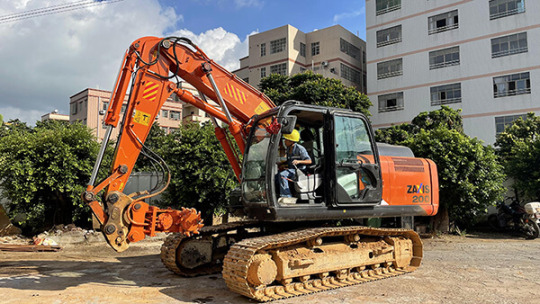
Mastering the Depths:
The excavator tunnel arm is a true titan of subterranean engineering. Equipped with a massive robotic arm, this machine is purpose-built to excavate tunnels efficiently and safely. These arms can reach impressive lengths, often extending up to 150 feet (45 meters), allowing them to navigate deep underground with precision. With an array of hydraulic joints and sophisticated controls, the arm can be maneuvered in any direction, enabling the excavator to work around obstacles and create tunnels of various shapes and sizes.
Unleashing Incredible Power:
Raw power lies at the core of the excavator tunnel arm capabilities. The arm is equipped with a formidable hydraulic system that generates immense force to break through tough terrain. Utilizing a combination of hydraulic cylinders, pumps, and motors, the arm exerts tremendous pressure to rip through rocks, soil, and other geological formations. Additionally, specialized cutting attachments, such as rotating drums or hydraulic hammers, further enhance the excavator’s ability to dislodge and remove the excavated material.
Precision and Efficiency:
In the world of tunnel construction, precision is paramount. The excavator tunnel arm shines in this regard, thanks to advanced positioning and guidance systems. These systems use cutting-edge technologies like GPS, laser scanners, and inertial sensors to ensure accurate excavation. The operator can rely on real-time data and visual displays to monitor the arm’s position, depth, and alignment, enabling them to maintain the desired tunnel profile with exceptional accuracy.

Versatility and Adaptability:
The excavator tunnel arm is a highly versatile machine, adaptable to diverse tunneling projects. It can be equipped with various specialized tools, including bucket attachments for soil excavation, augers for drilling, or even rock-breaking devices for challenging terrains. This adaptability allows the machine to tackle a wide range of underground construction tasks, from creating tunnels for transportation networks, such as subways or underground railways, to installing utility pipes and cables beneath our cities.
Conclusion:
The excavator tunnel arm represents the pinnacle of engineering ingenuity in the realm of underground construction. Through its power, precision, and versatility, it plays a crucial role in shaping the subterranean landscape of our modern cities. With ongoing advancements in technology, we can expect even greater efficiencies and capabilities from these engineering marvels. As we continue to expand our underground infrastructure, the excavator tunnel arm will remain an invaluable tool, enabling us to carve a path forward and connect our world beneath the surface.
Safety and Environmental Considerations:
Safety is of paramount importance in any construction project, and excavator tunnel arms are designed with stringent safety features. The operator’s cabin is equipped with protective structures, including reinforced glass and rollover protection, ensuring the operator’s well-being during operations. Additionally, advanced monitoring systems provide real-time data on the machine’s performance, detecting any anomalies or potential issues.
Moreover, environmental considerations play a vital role in underground construction. Excavator tunnel arm incorporate features to minimize their ecological footprint. Dust control measures, such as water sprays and ventilation systems, mitigate airborne particles. The use of efficient engines and emission control technologies reduces pollution, while noise dampening features help mitigate noise pollution in urban environments.
Innovations and Future Prospects:
Excavator tunnel arm continue to evolve as technological advancements push the boundaries of what is possible. Researchers are exploring autonomous capabilities, where machines can operate with minimal human intervention, improving productivity and safety. Integration with artificial intelligence and machine learning algorithms could optimize excavation processes and enhance decision-making during complex tunneling projects.
Furthermore, the development of electric-powered excavator tunnel arms is gaining momentum, reducing carbon emissions and noise pollution even further. These eco-friendly alternatives have the potential to revolutionize underground construction, making it more sustainable and environmentally friendly.
Conclusion:
The excavator tunnel arm’s power, precision, adaptability, safety features, and ongoing technological advancements make it an indispensable tool for underground construction. Its ability to carve through the earth with efficiency and accuracy allows us to create intricate tunnel networks that connect communities, facilitate transportation, and support vital infrastructure. As we embrace the challenges of expanding our underground realms, the excavator tunnel arm will continue to push the boundaries of engineering, playing a crucial role in shaping the subterranean future of our world.
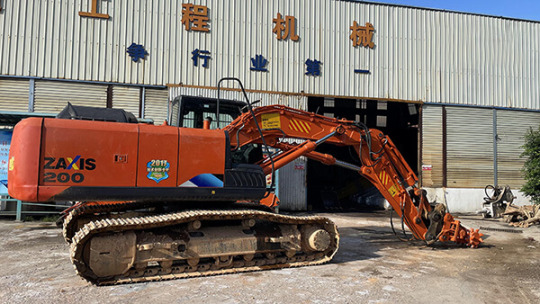
Pushing the Limits: Mega Projects:
Excavator tunnel arms have proven their mettle in some of the most ambitious tunneling projects around the world. From the Channel Tunnel connecting the United Kingdom and France to the vast network of tunnels in the Tokyo Metro, these machines have played a pivotal role in shaping monumental engineering achievements. Mega projects, such as the expansion of subway systems, the construction of underground highways, and the creation of hydroelectric tunnels, rely on the sheer power and precision of excavator tunnel arms to overcome the challenges of complex geological conditions and demanding schedules.
Collaboration and Teamwork:
Excavator tunnel arms are not solitary machines but rather integral parts of larger construction teams. Skilled operators work in coordination with engineers, geologists, and surveyors to ensure the successful completion of tunneling projects. Collaboration and teamwork are essential for efficient excavation, accurate geological mapping, and the implementation of safety protocols. The synchronized efforts of these professionals, combined with the cutting-edge technology of the excavator tunnel arms, result in the creation of safe and reliable underground passages.

Bridging the Divide:
The excavator tunnel arm bridges more than just physical divides—it connects people and places, enhancing accessibility and fostering economic growth. By creating tunnels for transportation networks, these machines facilitate the movement of people and goods, reducing congestion on surface roads and improving connectivity across regions. Additionally, they play a crucial role in the development of underground utility networks, ensuring the efficient delivery of essential services like water, electricity, and telecommunications. Excavator tunnel arms are the silent architects of a connected world, enabling us to overcome geographical barriers and bring communities closer together.
Conclusion:
As we venture deeper into the ground to meet the challenges of urbanization and infrastructure development, the excavator tunnel arm stands as a testament to human ingenuity and engineering prowess. With its immense power, precision, adaptability, and ongoing innovations, this extraordinary machine continues to shape our underground world, unlocking new possibilities for transportation, utilities, and urban expansion. The excavator tunnel arm, alongside the collaborative efforts of skilled professionals, is instrumental in building a future where the depths of the earth are harnessed to create sustainable, efficient, and interconnected cities for generations to come.
0 notes
Text
Building Strong Foundations: Harnessing the Strength of Excavator Piling Booms
In the realm of construction and engineering, excavators play a crucial role in shaping the modern world. These versatile machines have evolved over time, becoming more powerful and efficient. One remarkable feature that has revolutionized the construction industry is the excavator piling arm. This technological marvel has surpassed conventional methods, enabling engineers to tackle challenging projects with precision, speed, and strength. In this article, we delve into the world of excavator piling arms, exploring their capabilities, applications, and the transformative impact they have on the construction landscape.

Understanding Excavator Piling Arm
The piling arm is an attachment that enhances the functionality of excavators, enabling them to perform specialized tasks such as pile driving, sheet piling, and foundation work. It consists of a powerful hydraulic system, a sturdy boom, and a pile-driving hammer or vibratory driver. The piling arm’s design allows it to penetrate various ground conditions effortlessly, driving piles into the earth to create stable foundations for structures.
Enhanced Efficiency and Precision
Excavator piling arm offer a substantial improvement in efficiency compared to traditional pile driving methods. Their hydraulic systems provide exceptional control over the pile-driving process, allowing operators to precisely position and drive piles with accuracy. This reduces the risk of errors, enhances safety, and minimizes unnecessary disruptions to surrounding structures.
Versatile Applications
The versatility of excavator piling arm makes them indispensable in a wide range of construction projects. From building bridges, retaining walls, and high-rise structures to constructing deep foundations for offshore platforms, piling arms adapt to various ground conditions and pile sizes. Their adaptability allows construction teams to work more efficiently, saving time and resources while ensuring the stability and durability of the structures they create.
Unleashing Power and Strength
Excavator piling arm harness impressive power to drive piles deep into the ground. With hydraulic systems capable of generating high impact forces, these arms deliver tremendous striking power to overcome resistance and penetrate tough soils. Additionally, vibratory drivers utilize oscillation to loosen surrounding soil, making it easier for piles to be inserted. This combination of power and strength enables efficient pile installation, even in challenging terrains.
Safety and Environmental Considerations
Excavator piling arms prioritize safety and minimize environmental impact. The precise control offered by hydraulic systems reduces the risk of accidental damage to nearby structures. Moreover, their ability to adapt to different pile sizes minimizes the disturbance caused to the surrounding environment. This ensures that the ecological balance of the construction site is maintained while protecting nearby flora, fauna, and groundwater resources.

Technological Advancements
The evolution of excavator piling arms has been fueled by technological advancements. Manufacturers continually innovate to improve efficiency, reliability, and operator comfort. Some of the recent advancements include automated pile alignment systems, real-time monitoring of driving parameters, and intelligent control systems that optimize the pile-driving process. These innovations enhance productivity, reduce downtime, and streamline construction operations.
Conclusion
Excavator piling arm have revolutionized the construction industry by providing unparalleled precision, strength, and efficiency in pile-driving operations. Their versatility allows engineers to undertake a wide range of projects while ensuring stability and durability. As technology continues to advance, we can anticipate even more remarkable enhancements in excavator piling arms, further propelling the construction industry into the future, and enabling the creation of awe-inspiring structures that stand the test of time.
Case Studies: Exemplifying Success
Numerous construction projects worldwide have benefited from the utilization of excavator piling arms. One notable example is the construction of the Burj Khalifa in Dubai, the world’s tallest skyscraper. Excavator piling arms played a crucial role in driving piles deep into the bedrock to create a stable foundation for this monumental structure. The precise control and immense power of the piling arms ensured the structural integrity of the Burj Khalifa, allowing it to withstand extreme winds and seismic forces.
Another case study is the construction of offshore wind farms. Excavator piling arms equipped with vibratory drivers have been instrumental in installing monopile foundations for wind turbine towers. The ability to adapt to varying soil conditions and pile sizes has made these arms indispensable in offshore environments. Their efficiency and strength have significantly reduced construction timelines and costs, making renewable energy more accessible.
Training and Skill Requirements
Operating excavator piling arm requires specialized training and expertise. Operators must understand the technical aspects of the equipment, including hydraulic systems, pile-driving techniques, and safety protocols. Proper training ensures optimal performance, minimizes the risk of accidents, and maximizes productivity. Construction companies often invest in comprehensive training programs to ensure their operators possess the necessary skills to operate excavator piling arms effectively and efficiently.
Future Trends and Innovations
The future of excavator piling arms looks promising, with ongoing research and development aimed at further enhancing their capabilities. One area of focus is the integration of advanced sensors and artificial intelligence, enabling real-time monitoring and analysis of pile-driving data. This will optimize the pile installation process, ensuring optimal pile capacity and reducing the need for manual adjustments. Additionally, advancements in materials and design are expected to make piling arms lighter, more durable, and energy-efficient.

Conclusion: Transforming the Construction Landscape
Excavator piling arms have revolutionized the way we approach construction projects, offering unparalleled precision, power, and efficiency. From high-rise buildings to critical infrastructure, these technological marvels have become indispensable tools for engineers and construction teams worldwide. As technology continues to advance, we can expect even more remarkable innovations that will further propel the capabilities of excavator piling arms, allowing us to construct complex structures with greater speed, accuracy, and sustainability. The future holds exciting possibilities as these powerful machines continue to reshape the construction landscape.
In conclusion, excavator piling arm represent a game-changing advancement in construction technology. Their ability to drive piles with precision, strength, and efficiency has transformed the industry, enabling engineers to tackle complex projects with ease. As we look ahead, the continued evolution of excavator piling arms promises further improvements, ensuring that construction projects are executed with enhanced safety, environmental consideration, and productivity. These machines stand as a testament to human ingenuity, propelling the boundaries of what we can achieve in the world of construction.
0 notes
Text
The Extraordinary Daily Applications of Excavator Long Arm
The excavator, with its mighty excavator long arm, is an iconic machine in the world of construction and engineering. While most people associate excavators with digging trenches and moving heavy loads, the versatile long arm of these machines enables them to accomplish a wide range of tasks. In this article, we delve into the lesser-known daily applications of excavator long arm and explore how these machines have revolutionized various industries.
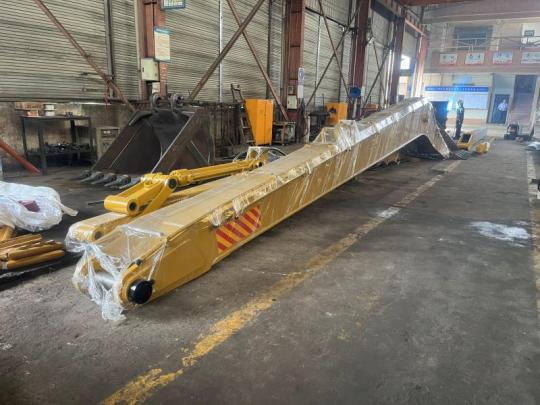
Construction and Demolition
Excavators equipped with long arms are indispensable in the construction and demolition industry. Their extended reach and powerful hydraulic systems make them ideal for tasks such as excavating deep foundations, demolishing structures, and lifting heavy materials. From digging trenches and basements to dismantling buildings with precision, the excavator long arm significantly enhances productivity and safety in these operations.
Landscaping and Earthmoving
In the realm of landscaping and earthmoving, the long arm of an excavator proves to be a game-changer. With its ability to reach over obstacles and access hard-to-reach areas, an excavator can shape landscapes, dig ponds, and level uneven terrain with remarkable efficiency. The long arm’s flexibility and precision enable delicate operations, such as transplanting trees or sculpting intricate terrain features, making it an invaluable tool for professional landscapers.
Utilities and Infrastructure
Maintaining and expanding utilities and infrastructure require careful excavation and installation of underground systems. Excavators with long arms excel in these tasks, allowing operators to dig trenches for laying pipelines, cables, and conduits. The extended reach of the long arm enables excavation and backfilling alongside busy roads or restricted spaces, reducing the need for additional machinery and minimizing disruptions to traffic flow.

Environmental Conservation
Excavator long arm find surprising applications in environmental conservation efforts. When it comes to restoring or creating wetlands, excavators can carefully remove sediment or vegetation using their long arms, reshaping the land to mimic natural waterways. These machines are also deployed to clear debris from rivers, facilitating water flow and preventing floods. By utilizing the long arm’s dexterity, operators can navigate delicate ecosystems while minimizing disturbance.
Mining and Extraction
Mining and extraction operations often involve moving vast amounts of material and reaching deep into the Earth. Excavators with long arms are indispensable in these industries, enabling efficient excavation of mineral deposits, removal of overburden, and loading of trucks. Their long reach and adaptability allow for effective extraction in open-pit mines, underground tunnels, and even underwater environments, maximizing productivity and ensuring worker safety.
Disaster Response and Recovery
Excavator long arms play a crucial role in disaster response and recovery efforts. In the aftermath of natural disasters such as earthquakes, hurricanes, or landslides, these machines are deployed to clear debris, remove obstacles, and aid in search and rescue operations. The long arm’s extended reach allows operators to access hard-to-reach areas, while its strength helps in moving heavy wreckage. Excavators have proven invaluable in restoring infrastructure, clearing roads, and facilitating the recovery process in affected communities.
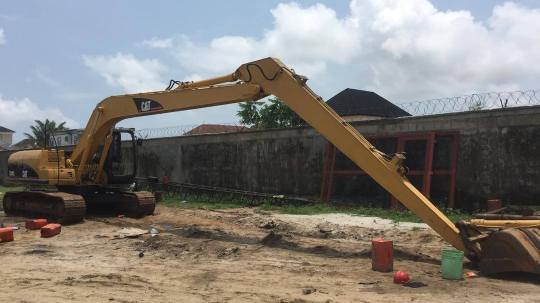
Marine and Waterway Maintenance
Excavator long arm are not limited to land-based applications. In marine and waterway maintenance, these machines are utilized to dredge rivers, lakes, and harbors. The long arm allows excavators to reach into the water, removing sediment, silt, and debris, thereby improving water flow and maintaining navigable channels. They are also used to construct and repair waterfront structures, such as docks and retaining walls, making excavators indispensable in maintaining vital water transportation infrastructure.
Agricultural Operations
The agricultural sector has also recognized the benefits of utilizing excavator long arm. In large-scale farming, these machines are used for tasks like land preparation, ditching, and irrigation system installation.
Excavators with long arms prove particularly useful in agricultural operations that require extensive land preparation. The long arm’s reach allows operators to clear land, remove rocks and debris, and level uneven terrain, creating a suitable foundation for planting crops. Additionally, these machines can efficiently dig irrigation channels and install drainage systems to optimize water management in agricultural fields.
Renewable Energy Projects
With the growing emphasis on renewable energy sources, excavator long arm have found their way into the development of wind farms and solar energy projects. During the construction phase, these machines are used to excavate foundations for wind turbine towers or solar panel arrays. The extended reach of the long arm enables efficient digging and leveling of large areas, facilitating the installation of infrastructure necessary for renewable energy generation.

Archaeological Excavations
Excavator long arm have revolutionized the field of archaeology by enabling efficient and precise excavations. In archaeological sites, where delicate artifacts and structures are buried, the long arm’s versatility and controllability allow archaeologists to excavate with great precision. By carefully removing layers of soil and debris, archaeologists can uncover ancient artifacts and structures while minimizing the risk of damage or disturbance.
Conclusion
The daily applications of excavator long arm extend far beyond traditional construction and excavation tasks. From disaster response and marine maintenance to agriculture, renewable energy, and even archaeology, these machines have become indispensable in various industries. Their extended reach, strength, and versatility enable operators to tackle complex projects with efficiency, precision, and safety. As technology advances, we can expect further innovations in excavator design, opening up new possibilities and expanding their utility in diverse fields. The excavator long arm continues to shape and transform our world in remarkable ways.
0 notes
Text
Unleashing the Power of the Excavator Ripper Boom: Unraveling Earth’s Secrets
The world of excavation and construction has witnessed remarkable advancements in machinery and equipment. Among the many innovations, the excavator ripper boom stands out as a game-changer, revolutionizing the way we uncover the secrets hidden beneath the Earth’s surface. Designed to break through tough terrain and tackle challenging excavation tasks, the ripper boom has become an indispensable tool for construction and mining industries worldwide. In this article, we delve into the inner workings of the excavator ripper boom, explore its capabilities, and highlight the invaluable role it plays in modern excavation.

The Anatomy of the Ripper Boom:
The excavator ripper boom is an attachment specifically designed for excavators, enabling them to penetrate and tear through dense soils, rocks, and other hard materials. It consists of a heavy-duty hydraulic arm, often equipped with a replaceable toothed attachment called a ripper tooth or ripper shank. The ripper tooth is engineered to deliver an immense force to break, rip, and pry apart the ground, making way for excavation or preparing the terrain for subsequent construction activities.
The Power Behind the Ripper Boom:
The ripper boom harnesses the power of hydraulic systems. Hydraulic cylinders located within the boom convert hydraulic pressure into mechanical force, enabling the ripper tooth to penetrate deep into the ground. The ripper tooth’s sharp edges, combined with the immense force exerted by the hydraulic system, create a powerful ripping action that effectively breaks up and dislodges compacted materials.
The Benefits and Applications:
The excavator ripper boom offers a plethora of benefits across various industries. In mining, it facilitates the extraction of valuable minerals and ore deposits from the Earth’s crust by efficiently breaking through rocky terrain. In construction, the ripper boom aids in site preparation, excavating trenches, and removing stubborn obstructions like tree stumps or large rocks.
Moreover, the ripper boom significantly enhances productivity and reduces manual labor requirements. Its ability to penetrate challenging surfaces quickly saves time and minimizes the need for additional machinery or manpower. This translates into substantial cost savings for project managers and contractors.
Additionally, the ripper boom promotes environmental sustainability. By swiftly breaking up and loosening the ground, it reduces the need for excessive excavation, thereby minimizing soil displacement and ecosystem disturbance. This feature makes it an eco-friendly alternative for excavation projects that prioritize environmental preservation.
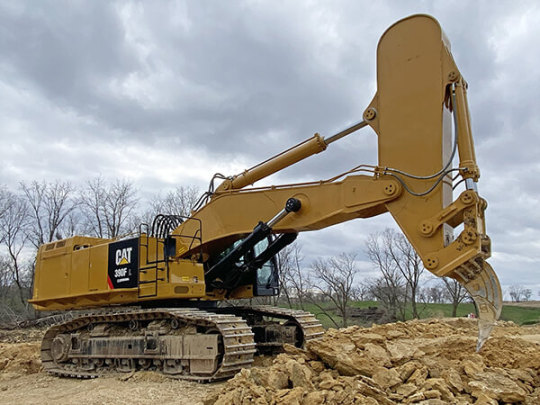
The Future of Excavation:
As technology continues to advance, the excavator ripper boom is poised to evolve further. Innovations such as intelligent hydraulic systems, advanced tooth designs, and automated control mechanisms hold immense potential to enhance the efficiency and versatility of the ripper boom. These developments will enable more precise control over the ripping process, better adaptability to varying soil conditions, and increased safety for operators.
Furthermore, with a growing focus on sustainable practices, researchers and engineers are exploring alternative energy sources, such as electric or hybrid-powered excavators, to drive the ripper boom’s operations. This shift could lead to reduced emissions, lower operational costs, and a greener future for the construction and mining industries.
Conclusion:
The excavator ripper boom has transformed the excavation landscape, providing an indispensable tool for breaking through tough surfaces and unearthing the hidden treasures of our planet. With its robust design, powerful ripping action, and numerous applications, the ripper boom has become a cornerstone of modern construction and mining operations. As technology continues to advance, the ripper boom’s capabilities will only grow, enabling us to delve deeper into the Earth’s mysteries while promoting sustainability and efficiency in the excavation industry.
The Success Stories:
Numerous success stories from around the world highlight the efficacy of the excavator ripper boom. In the mining industry, this powerful attachment has been instrumental in accessing valuable mineral deposits that were previously deemed inaccessible. By effortlessly breaking through tough rock formations, it has enabled mining companies to reach deeper reserves and maximize their extraction potential.
In the construction sector, the ripper boom has proven indispensable in site preparation for large-scale infrastructure projects. It efficiently removes obstructions and clears the way for subsequent construction activities, saving time and resources. The ripper boom’s versatility is evident in its ability to handle a wide range of terrains, from soft soils to compacted clay and rocky landscapes.
Moreover, the ripper boom has found applications in agricultural practices. It aids in land development for farming, helping to clear fields and remove debris, enabling efficient irrigation and enhancing crop productivity.
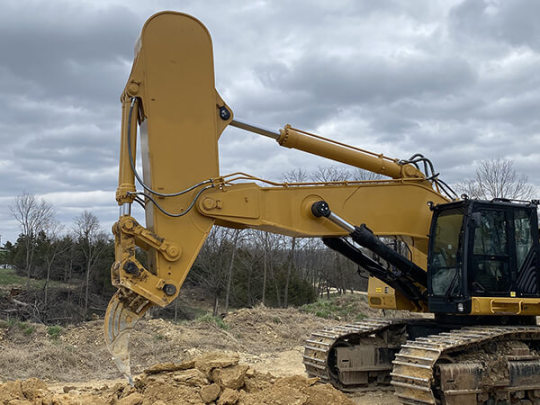
Safety Considerations:
While the ripper boom offers tremendous power and efficiency, it is crucial to prioritize safety during its operation. Operators must receive proper training to ensure they understand the equipment’s capabilities, limitations, and safety protocols. Regular maintenance and inspections of the ripper boom are essential to identify any potential issues that may compromise its performance or endanger personnel.
Furthermore, safety features such as protective guards, emergency shut-off switches, and operator warning systems should be implemented to minimize risks. Adherence to safety guidelines and regulations is imperative to ensure the well-being of operators and those working in close proximity to the ripper boom.
Conclusion :
The excavator ripper boom has undoubtedly left an indelible mark on the excavation and construction industries. Its power, versatility, and efficiency have propelled excavation operations to new heights, uncovering hidden resources and transforming landscapes. As we look ahead, continued innovation and advancements in the ripper boom’s design will further optimize its performance, while prioritizing safety and environmental sustainability. With this remarkable tool at our disposal, we can confidently explore the depths of our planet, unveil its secrets, and pave the way for a brighter future in the world of excavation.
0 notes
Text
Unleashing the Power of Reach: The Marvels of Digger Long Front Boom
Construction and excavation projects often require reaching new heights or digging deeper depths. Thanks to the marvels of modern engineering, the digger long front boom has revolutionized the industry. In this article, we will explore the design, applications, advantages, limitations, and the incredible ways in which long reach booms enhance the capabilities of standard excavators.

The Anatomy of a Long Reach Boom
A long front boom is a unique attachment that extends the reach of an excavator. It typically consists of an extended arm and boom, replacing the standard configuration. Meticulously engineered and constructed using high-quality materials, digger long front boom are designed to withstand demanding construction site conditions.
The extended arm allows the excavator to reach further distances, while the boom provides stability and support. The arm is longer and lighter than the standard arm, enabling increased maneuverability. The boom connects the arm to the excavator’s main body, ensuring stability and transferring hydraulic power to operate the attachment effectively.
Unleashing the Reach
The primary purpose of an excavator long front boom is to extend the machine’s reach beyond its standard capabilities. By attaching a long reach boom, an excavator gains access to areas that were previously out of reach. Deep trenches, high walls, and structures requiring demolition become more accessible. Long reach booms offer unparalleled flexibility, allowing construction and excavation projects to be completed with greater ease.
In dredging projects, excavators with long reach booms effectively remove sediment and debris from bodies of water, deepening channels or creating new waterways. Deep foundation excavations benefit from the extended reach, enabling excavation at greater depths to stabilize structures. Slope finishing, river or canal maintenance, and environmentally sensitive projects also benefit from long reach booms, as they allow work to be completed without disturbing the surrounding landscape.

Engineering Marvels
Creating a reliable and efficient long reach boom requires precise engineering and meticulous attention to detail. Engineers calculate stress points, weight distribution, and hydraulic systems to ensure optimal performance. High-tensile steel and other durable materials withstand the extreme forces and pressures encountered during operation. These engineering marvels demonstrate the synergy between cutting-edge technology and the demands of modern construction.
Hydraulic systems play a crucial role in digger long front boom operation. Hydraulic cylinders, pumps, and valves work together to extend and retract the arm, control the boom’s movement, and provide power for digging and lifting. Advanced hydraulic systems allow for precise control, smooth operation, and enhanced operator productivity and safety.
Advantages and Limitations
Long reach booms offer numerous advantages, but it’s important to consider their limitations. The extended reach comes at the expense of reduced lifting capacity and stability. The excavator’s center of gravity shifts when using a long reach boom, making it less suitable for heavy lifting tasks. Operators must be mindful of load capacities and operating parameters to maintain safety and performance.
Despite the limitations, long reach booms provide exceptional benefits. They enable access to otherwise challenging areas, saving time and labor costs. The increased reach enhances project efficiency, allowing work to be completed without requiring additional equipment or manual labor. Long reach booms also minimize site disruption, especially in sensitive environments, by reducing the need for excessive earthmoving or land alteration.
Future Developments
As technology advances, the capabilities of long reach booms continue to expand. Engineers and manufacturers are constantly exploring ways to improve reach and performance while addressing the limitations of current designs. One area of development focuses on enhancing the lifting capacity of long reach booms without compromising stability. This involves innovations in structural design, material selection, and hydraulic systems to optimize the balance between reach and lifting capabilities.
Additionally, advancements in hydraulic control systems aim to provide even greater precision and responsiveness. This allows operators to fine-tune the movements of the long reach boom, enabling more delicate operations in restricted spaces. Improved control systems can also enhance safety features, such as automatic overload protection and real-time monitoring of hydraulic pressure and stability.
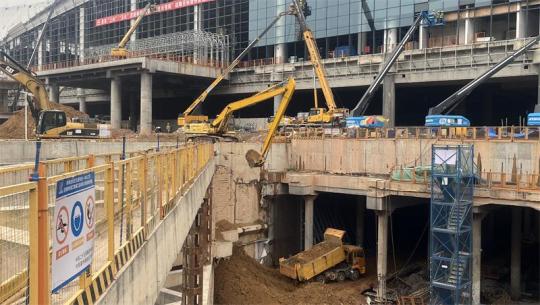
Furthermore, researchers are exploring the integration of sensor technologies and automation into long reach booms. By incorporating cameras, LiDAR, and other sensors, excavators equipped with long reach booms can provide operators with real-time feedback on the surrounding environment, enhancing situational awareness and improving accuracy during operations. Automation features can assist in repetitive tasks and streamline operations, improving overall efficiency.
Another area of development focuses on environmental sustainability. Manufacturers are exploring ways to reduce the carbon footprint of long reach booms by improving energy efficiency and incorporating eco-friendly materials. This includes the use of hybrid or electric power systems and the integration of regenerative braking systems to capture and reuse energy during operation.
In conclusion, digger long front boom have revolutionized the construction and excavation industry by extending the reach and capabilities of standard excavators. Through meticulous engineering and advanced hydraulic systems, these attachments provide access to challenging areas and enhance project efficiency. While they have certain limitations, the advantages of digger long front boom, such as increased flexibility and reduced site disruption, make them invaluable tools in a wide range of applications. As technology continues to advance, we can expect further improvements in reach, lifting capacity, precision, automation, and sustainability, opening up new possibilities for construction and excavation projects in the future.
0 notes
Text
Comparison of the advantages of excavator long reach front and telescopic arm
When it comes to construction, excavation is a crucial process that requires specialized equipment to be carried out efficiently. Two of the most popular types of excavators used in the industry are the excavator long reach front and the excavator telescopic arm. In this article, we will be comparing the two types of excavators, highlighting their differences, strengths, and weaknesses.
Firstly, let’s take a closer look at the excavator long reach front. As the name suggests, the long reach excavator is designed to have an extended reach, making it ideal for digging deep into the ground or reaching difficult areas. This excavator is typically used for projects that require excavation in deep waters or for shoreline work, where the equipment needs to be placed on dry ground while digging out sediment under the water. The excavator long reach front also provides better stability than other types of excavators, which makes it ideal for digging trenches or foundations for buildings.
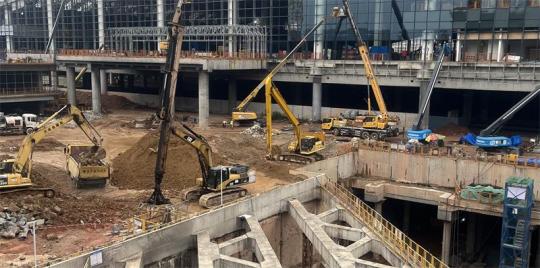
Advantage
On the other hand, the excavator telescopic arm is designed with an extendable arm that can reach higher levels than other excavators. This excavator is suitable for construction projects that require digging in deep areas, as it can reach a greater depth than traditional excavators. Additionally, the excavator telescopic arm can be used for demolition projects, as it can reach high floors of buildings and other structures that require demolition.
One significant advantage of the excavator telescopic arm is that it has a greater lifting capacity than the long reach excavator. This means that it can carry more significant loads and is better suited for heavier projects such as demolition work. The telescopic arm excavator is also more versatile, as it can be used in a wide range of construction projects, making it a more popular choice for contractors.

Shortcoming
However, the excavator telescopic arm is not without its weaknesses. The extendable arm of the excavator is prone to wear and tear, and it requires more maintenance than the excavator long reach front. The telescopic arm excavator is also more expensive than the long reach excavator, which may make it less accessible for smaller construction companies.
In conclusion, the choice between the excavator long reach front and the telescopic arm excavator depends on the specific requirements of the construction project. If a project requires deep excavation or digging in unstable areas, the long reach excavator is the better choice. If the project requires excavation in deep areas, demolition work, or requires a higher lifting capacity, then the excavator telescopic arm is the better option. Ultimately, both excavators are essential for construction projects, and choosing the right one for the job is critical to ensure the success of the project.
0 notes
Text
How to do daily maintenance of excavator tilt bucket
Excavators are heavy machinery that are used for a variety of tasks, including construction, demolition, and mining. They have a excavator tilting bucket that allows the operator to easily pick up and move large amounts of material. However, like all machinery, excavators require regular maintenance in order to operate at peak efficiency. In this article, we will discuss the daily maintenance of the tilting bucket of the excavator.

Clean
Clean the excavator tilting bucket after each use After using the excavator, it is important to clean the tilting bucket thoroughly. This will help prevent the buildup of dirt, debris, and other materials that can damage the bucket over time. Use a high-pressure washer or hose to clean the bucket thoroughly, paying special attention to the joints and pivot points.
Examine
Check for wear and tear Inspect the tilting bucket daily for any signs of wear and tear. Check for cracks, dents, and other signs of damage that could compromise the bucket’s structural integrity. If any damage is found, it should be repaired immediately.
Lubricate the joints Proper lubrication is essential for the smooth operation of the tilting bucket. Check the lubrication points daily and apply the recommended lubricant as needed. This will help prevent premature wear and tear on the bucket’s joints and pivot points.

Check the hydraulic system The hydraulic system is an essential component of the excavator tilt bucket. Check the hydraulic fluid levels daily and add more if necessary. Look for any leaks or other signs of damage in the hydraulic lines and hoses. If any issues are found, they should be addressed immediately.
Store the excavator tilting bucket properly When the excavator is not in use, it is important to store the tilting bucket properly. This will help prevent damage from exposure to the elements, such as rain, snow, and UV radiation. Store the bucket in a dry, covered area and make sure it is properly secured to prevent it from falling or being damaged.
In conclusion, daily maintenance is essential for the proper functioning of the excavator tilting bucket. By following these simple steps, you can help ensure that your excavator operates at peak efficiency and remains in good working condition for years to come. Remember to always follow the manufacturer’s guidelines for maintenance and repair, and to seek professional help if you are unsure about any aspect of maintenance or repair.
0 notes
Text
How is the excavator demolition arm made?
Excavator demolition arms are impressive pieces of machinery that are widely used in the construction industry. They are specifically designed to demolish buildings, bridges, and other structures that need to be taken down. In this article, we will discuss the process of how the excavator demolition arm is made.

Design
The first step in making an excavator demolition arm is to design the arm itself. Engineers and designers work together to create a blueprint that outlines the exact specifications of the arm. They take into account factors such as the weight and size of the arm, the materials to be used, and the maximum weight it will need to carry.
Once the design is complete, the manufacturing process can begin. The first step is to cut and shape the metal that will be used to construct the arm. Typically, this is done using a large cutting machine that can handle the thickness of the metal. The metal is then shaped using a press machine or a bending machine to give it the required shape.

After the metal is cut and shaped, it is time to weld the pieces together. This is done using an arc welding machine, which uses an electric arc to melt the metal and create a strong bond between the pieces. The welding process is crucial, as the strength of the arm will depend on the quality of the welds.
Once the arm has been welded together, it is time to add the hydraulic system. The hydraulic system is what allows the arm to move and operate. It consists of hydraulic pumps, valves, and hoses that are all connected to a control panel. The control panel allows the operator to control the arm’s movements and adjust the amount of pressure that is being applied.

Finally, the excavator demolition arm is painted and given a protective coating to prevent rust and corrosion. The paint and coating not only make the arm look more attractive, but they also extend its lifespan and ensure that it can withstand the harsh conditions it will face in the construction industry.
In conclusion, the process of making an excavator demolition arm is a complex one that involves careful planning, precise cutting and shaping, expert welding, and the installation of a sophisticated hydraulic system. The result is a powerful and efficient piece of machinery that can take down even the most challenging structures with ease.
0 notes
Text
How to replace the Caterpillar excavator joystick handle
Caterpillar excavators are heavy-duty machines widely used in construction and excavation projects. The joystick handle is an essential part of a Caterpillar excavator, as it controls the movement of the machine’s arm and bucket. Over time, the joystick handle may become damaged or worn out, and replacing it is necessary to maintain the excavator’s optimal performance. Here’s a step-by-step guide on how to replace the Caterpillar excavator joystick handle.

Step 1: Turn off the Excavator
Before you begin any repair work, ensure that the Caterpillar excavator’s engine is turned off, and the key is removed from the ignition. This step will prevent any accidental movement of the machine and keep you safe during the repair process.
Step 2: Identify the Joystick Handle
Identify the excavator joystick handle that needs to be replaced. For Caterpillar excavators, the joystick handles are typically located on the right-hand side of the operator’s seat.
Step 3: Remove the Old Joystick Handle
Remove the old joystick handle by locating the retaining bolts that hold it in place. Once the bolts are removed, gently pull the old joystick handle out of the control panel.
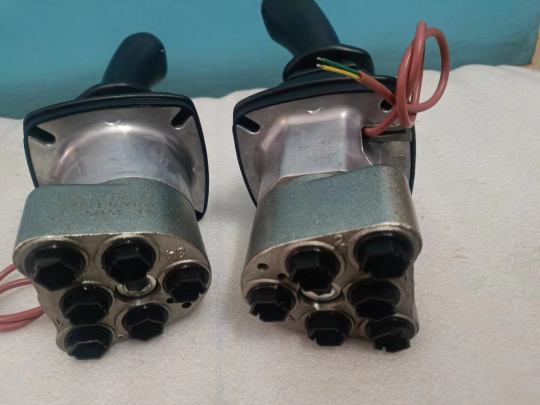
Step 4: Install the New Caterpillar excavator joystick handle
Insert the new joystick handle into the control panel and secure it in place with the retaining bolts. Ensure that the bolts are tightened to the manufacturer’s specifications to avoid any loose parts that could affect the excavator’s performance.
Step 5: Connect the Wiring
Connect the wiring for the new joystick handle. Caterpillar excavators have a wiring harness that connects the joystick handle to the control panel. Ensure that the wiring is connected correctly to avoid any electrical issues.
Step 6: Test the New joystick handle
After installing the new joystick handle, test it to ensure that it works correctly. Turn on the Caterpillar excavator and move the arm and bucket to test the new joystick handle’s responsiveness. Check that there are no issues with the machine’s movement and that everything is working correctly.

Step 7: Clean up
Once you have confirmed that the new Caterpillar excavator joystick handle is working correctly, turn off the Caterpillar excavator, and clean up the work area. Dispose of the old joystick handle appropriately and ensure that all tools and equipment used during the repair process are stored correctly.
In conclusion, replacing the Caterpillar excavator joystick handle is a straightforward process that requires minimal tools and expertise. By following the steps outlined above, you can easily replace a worn-out or damaged joystick handle and keep your Caterpillar excavator in optimal condition. Remember to always prioritize safety during any repair work and consult a professional if you encounter any difficulties during the repair process.
0 notes
Text
About how to use the excavator flail mowers correctly
Excavator flail mowers are powerful tools that are designed to clear vegetation in a variety of settings. Whether you are working in agriculture, forestry, or construction, an excavator flail mower can help you quickly and efficiently clear vegetation. However, it is important to use this tool correctly to ensure your safety and the safety of those around you. In this article, we will discuss how to use the excavator flail mowers correctly.

Understand the controls:
Before using the excavator flail mowers, it is important to understand the controls. Familiarize yourself with the levers and switches that control the movement of the machine and the flail mower attachment. Make sure you know how to stop the machine quickly in case of an emergency.
Inspect the machine:
Before using the excavator flail mower, inspect it for any damage or wear and tear. Check the hydraulic lines for leaks and ensure that all bolts and fittings are tight. If you notice any damage or wear and tear, do not use the machine until it has been repaired.
Clear the area:
Before using the excavator flail mower, clear the area of any obstacles that could interfere with the machine or pose a hazard to those around you. Remove any rocks, debris, or other objects that could cause damage to the machine or cause it to become stuck.
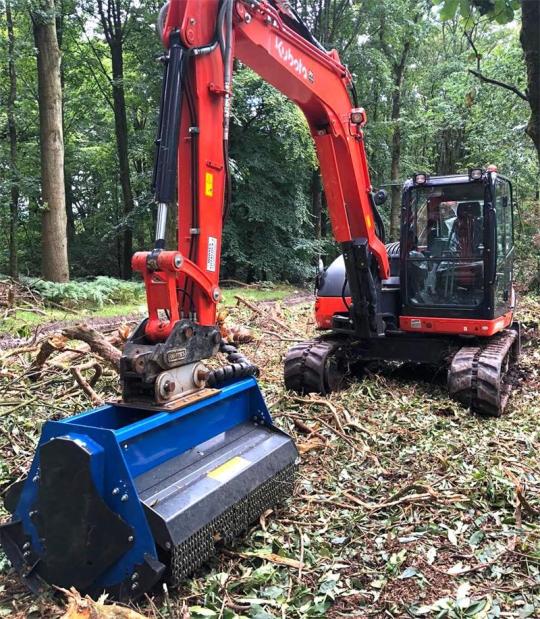
Wear appropriate safety gear:
When using the excavator flail mowers, it is important to wear appropriate safety gear, including a hard hat, eye and ear protection, gloves, and sturdy work boots.
Operate the machine safely:
When operating the excavator flail mower, keep the machine on a level surface and maintain a safe distance from any obstacles or hazards. Use the flail mower attachment to clear vegetation in a controlled manner, making sure to avoid hitting rocks or other hard objects.
Maintain the machine:
After using the excavator flail mowers, clean it thoroughly and inspect it for any damage or wear and tear. Store the machine in a safe and secure location to prevent theft or damage.
In conclusion, the excavator flail mowers is a powerful tool that can help you clear vegetation in a variety of settings. However, it is important to use this tool correctly to ensure your safety and the safety of those around you. Follow the tips outlined in this article to use the excavator flail mower safely and efficiently.
0 notes
Text
Daily maintenance rules for excavator telescopic arm
Excavators are heavy equipment machines used in construction, mining, and other industries to dig and move large amounts of materials. The excavator telescopic arm is one of the essential components of an excavator that is responsible for extending the reach of the machine. Proper maintenance of the excavator telescopic arm is crucial for ensuring the efficient operation and longevity of the machine. In this article, we will discuss how to maintain the excavator telescopic boom.
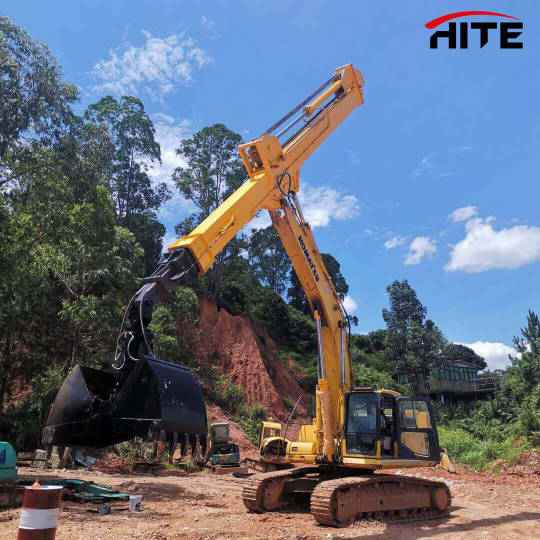
Clean the excavator telescopic arm regularly: Regular cleaning of the telescopic arm can help prevent corrosion and buildup of dirt and debris. Use a pressure washer or a hose to clean the arm thoroughly. Use a soft-bristled brush to remove any dirt or grime that may be stuck on the arm.
Check for wear and tear: Regularly inspect the telescopic arm for any signs of wear and tear. Check for cracks, dents, or any other damage that may affect the functionality of the arm. Replace any damaged parts immediately to avoid further damage to the machine.

Lubricate the excavator telescopic boom: Proper lubrication of the telescopic arm is crucial for smooth operation. Apply grease to the joints and moving parts of the arm regularly to ensure smooth movement. Check the manufacturer’s recommendations for the type of grease to use and the frequency of lubrication.
Keep the arm in a retracted position: When the excavator is not in use, retract the excavator telescopic boom and secure it in place. This helps prevent damage to the arm and reduces the risk of accidents.
Operate the machine carefully: Operate the excavator carefully to avoid putting unnecessary strain on the telescopic arm. Avoid hitting the arm against hard surfaces or overloading the machine. Follow the manufacturer’s recommendations for operating the machine to ensure its longevity.
In conclusion, maintaining the telescopic boom of an excavator is essential for the efficient operation and longevity of the machine. Regular cleaning, inspection, lubrication, and proper operation are some of the key steps in maintaining the arm. By following these tips, you can ensure that your excavator telescopic boom remains in top condition, helping you to complete your construction projects with ease.
0 notes
Text
How to maintain the Caterpillar excavator buckets daily?
Caterpillar excavator buckets are essential components of excavators, and their maintenance is critical to ensure their longevity and efficient performance. Daily maintenance of Caterpillar excavator buckets is vital to prevent costly repairs and minimize downtime due to breakdowns. Here are some maintenance tips to keep Caterpillar excavator buckets in good working condition.
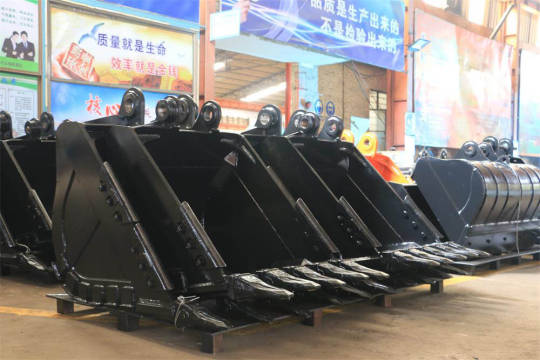
Clean the Bucket Regularly
Dirt and debris can accumulate on the bucket and reduce its performance. Therefore, it is essential to clean the bucket regularly. Cleaning the bucket with a pressure washer or a hose and a brush can help remove dirt and debris. Ensure that the bucket is dry before storing it to prevent rusting.
Check for Wear and Tear
Inspect the excavator buckets regularly for any signs of wear and tear. Check for cracks, bends, or any other damage that may affect the bucket’s performance. Replace any worn-out parts immediately to avoid further damage.
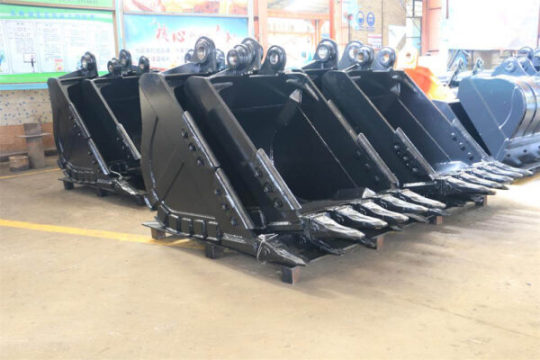
Check the Teeth and Adapters
The teeth and adapters on the bucket are crucial to its performance. Check them regularly for any signs of wear and tear. Replace any worn-out teeth and adapters immediately to avoid damage to the bucket and the machine.
Lubricate Moving Parts
Lubricating moving parts such as pins and bushings can prevent premature wear and tear. Apply grease to the moving parts regularly to reduce friction and prolong their life.
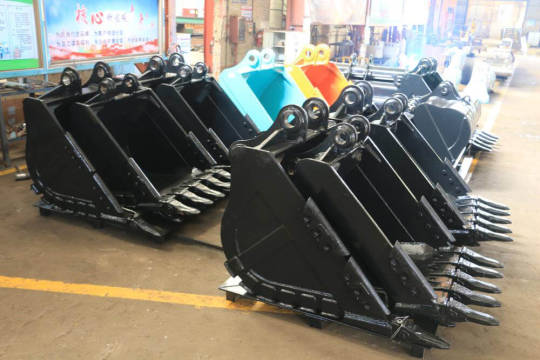
Store the Bucket Correctly
Storing the bucket correctly can prevent damage and prolong its life. Store the bucket in a dry place away from direct sunlight and moisture. Use a cover to protect the bucket from dust, debris, and weather elements.
Train Operators
Operators should be trained on the proper use and maintenance of the Caterpillar excavator buckets. They should be aware of the correct digging techniques to avoid excessive wear and tear on the bucket.

Conclusion
Daily maintenance of Caterpillar excavator buckets is essential to prevent costly repairs and minimize downtime due to breakdowns. Cleaning the bucket regularly, checking for wear and tear, lubricating moving parts, storing the bucket correctly, and training operators are some of the tips to keep Caterpillar excavator buckets in good working condition. Regular maintenance can prolong the bucket’s life, reduce downtime, and improve the overall performance of the machine.
0 notes
Text
Excavator Piling Arm: Ideal for a Wide Range of Projects
An excavator piling arm, also known as a pile driver attachment, is a versatile and efficient tool that can be used in a variety of construction and infrastructure projects. This specialized attachment is mounted onto an excavator’s boom and is used to drive piles into the ground with force. Here are some of the projects where an excavator piling arm is particularly useful:

Building foundations
An excavator piling arm is ideal for installing foundation piles for buildings. When constructing a new building, a solid foundation is crucial, and piles are often used to create a stable base. The piling arm allows for precise control of the pile driving process, ensuring that the piles are driven to the correct depth and at the correct angle.
Bridges
Pile driving is also essential for building bridges, as piles are used to support the weight of the bridge and transfer it to the ground. An excavator piling arm is particularly useful for bridge construction projects as it allows for the installation of piles in difficult-to-reach areas, such as in water or on steep slopes.
Wharves and jetties
Excavator piling arms are also commonly used in marine construction projects, such as building wharves and jetties. The piling arm is used to drive piles into the seabed to create a solid foundation for the structure. This is a challenging task as the piles must be installed accurately to ensure that the structure is stable.

Retaining walls
Retaining walls are used to hold back soil or rock and prevent landslides or erosion. Excavator piling arms can be used to install piles for retaining walls, providing a strong and stable foundation that can withstand the pressure of the soil or rock.
Solar and wind farms
Excavator piling arms are also used in the construction of solar and wind farms. The piles are driven into the ground to support the weight of the solar panels or wind turbines, providing a stable base that can withstand the elements.
In conclusion, an excavator piling arm is a versatile and efficient tool that can be used in a wide range of construction and infrastructure projects. Whether it’s building foundations, bridges, wharves, retaining walls, or renewable energy projects, the piling arm allows for precise and accurate pile driving, ensuring a solid foundation for the structure. If you’re working on a project that requires the installation of piles, an excavator piling arm is definitely worth considering.
0 notes
Text
Daily maintenance and maintenance of excavator piling hammer
Excavator piling hammer are heavy-duty construction equipment that are designed to drive piles into the ground. They are an essential tool for many construction and mining projects, and they are used extensively in the building of bridges, highways, and other large-scale infrastructure projects. However, like any piece of heavy machinery, excavator piling hammers require regular maintenance to ensure their continued safe and effective operation. In this article, we will discuss the daily use and maintenance of excavator piling hammers.
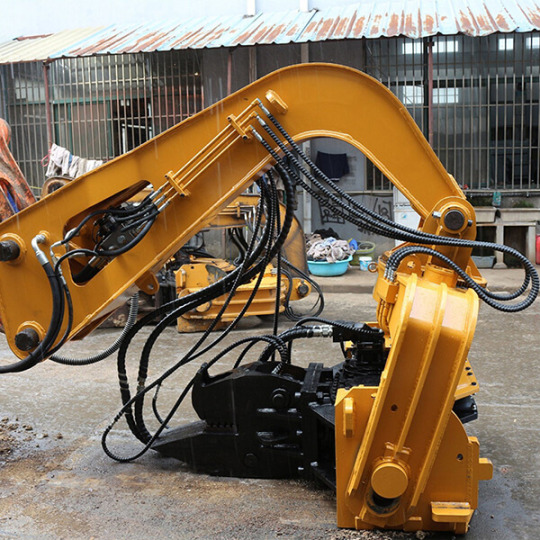
Daily Use
The daily use of an excavator piling hammer involves several steps, including:
Inspecting the Equipment: Before using the piling hammer, it is important to conduct a visual inspection of the equipment to ensure that it is in good condition. This includes checking the hydraulic hoses, fittings, and other components for signs of damage or wear.
Preparing the Work Area: The work area should be cleared of any obstacles or debris that could interfere with the operation of the piling hammer. This includes removing rocks, branches, and other objects from the area.
Positioning the Piling Hammer: The piling hammer should be positioned so that it is aligned with the pile that needs to be driven into the ground. The excavator should also be positioned so that it is stable and secure.
Operating the Piling Hammer: Once the excavator piling hammer is properly positioned, it can be operated using the controls on the excavator. The hammer should be used in a controlled manner to ensure that the pile is driven into the ground at the correct depth.

Maintenance
The maintenance of an excavator piling hammer is essential for its continued safe and effective operation. The following are some maintenance tips for excavator piling hammers:
Regular Inspections: Regular inspections of the piling hammer should be conducted to check for signs of damage or wear. This includes inspecting the hydraulic hoses, fittings, and other components for signs of wear.
Lubrication: The piling hammer should be properly lubricated to ensure that it operates smoothly and efficiently. This includes lubricating the bearings, seals, and other moving parts.
Cleaning: The excavator piling hammer should be cleaned regularly to remove any dirt or debris that could interfere with its operation. This includes cleaning the hydraulic system and the exterior of the equipment.
Repairs: Any damage or wear to the piling hammer should be repaired promptly to prevent further damage to the equipment. This includes replacing worn or damaged parts and repairing any leaks in the hydraulic system.

In conclusion, excavator piling hammer are essential equipment for many construction and mining projects. Proper daily use and maintenance of these hammers are crucial for their continued safe and effective operation. By following the tips outlined in this article, you can ensure that your excavator piling hammer operates smoothly and efficiently, minimizing downtime and maximizing productivity on your construction or mining project.
0 notes
Text
About Excavator Vibratory Hammer Overview
An excavator vibratory hammer is a powerful tool that is used to drive piles into the ground. It is attached to an excavator and works by using vibrations to break up soil particles and compact the ground around the pile. This method of pile driving is often preferred over traditional methods because it is quicker, more efficient, and causes less noise and vibration.

How does an Excavator Vibratory Hammer Work?
The excavator vibratory hammer works by attaching it to an excavator and positioning it over the pile. Once in position, the hammer is activated, and it starts to vibrate. The vibrations from the hammer are transferred to the pile, causing the soil particles around it to loosen up and compact.
As the soil is compacted, the pile is driven deeper into the ground. The vibrations also help to reduce the friction between the soil and the pile, making it easier to drive the pile into the ground. The process is repeated until the pile reaches the desired depth.
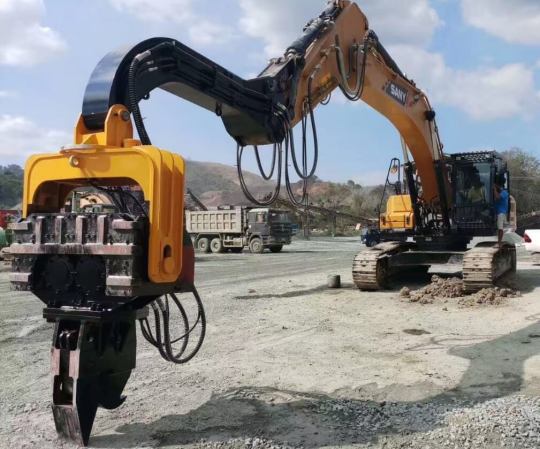
Benefits of Using an Excavator Vibratory Hammer
The use of an excavator vibratory hammer offers several benefits over traditional pile driving methods. Some of the benefits include:
Quicker and more efficient:
The use of an excavator vibratory hammer is quicker and more efficient than traditional pile driving methods. This is because the hammer vibrates at a high frequency, causing the soil to loosen up and compact quickly.
Less noise and vibration:
Traditional pile driving methods can be very noisy and cause a lot of vibration, which can be disruptive to nearby buildings and structures. The use of an excavator vibratory hammer causes less noise and vibration, making it a more environmentally friendly option.
Improved accuracy:
The use of a vibratory pile hammer allows for better accuracy in the placement of piles. This is because the hammer can be easily adjusted to ensure that the pile is driven to the desired depth and in the correct position.

Versatility:
An vibratory pile hammer can be used for a wide range of applications, including bridge construction, building construction, and port and harbor construction.
Cost-effective:
The use of a vibratory pile hammer can be cost-effective, especially when compared to traditional pile driving methods. This is because it requires less labor and equipment, and it is quicker and more efficient.
Conclusion
In conclusion, the vibratory pile hammer is a powerful tool that offers several benefits over traditional pile driving methods. It is quicker, more efficient, and causes less noise and vibration. Its versatility and cost-effectiveness make it an ideal choice for a wide range of applications. If you are looking for a reliable and efficient way to drive piles into the ground, an excavator vibratory hammer may be the perfect solution for you.
0 notes